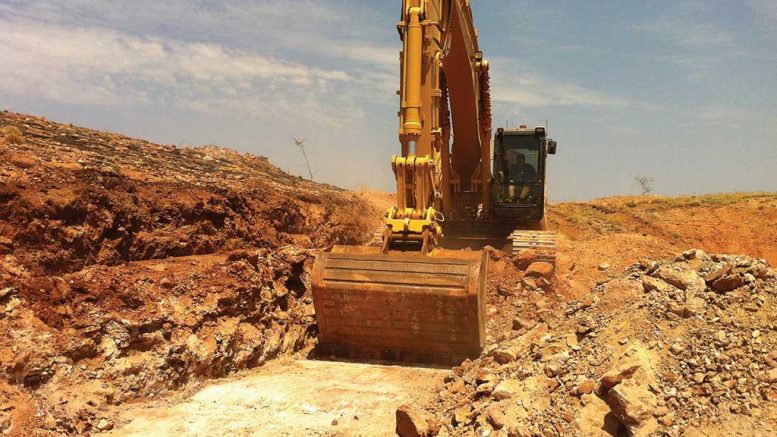VANCOUVER — A looming decline in production from Australia’s gold mining industry could be a wake-up call for explorers worldwide, MinEx Consulting managing director Richard Schodde says.
The industry soothsayer has assessed the 40-year outlook for the Australian gold-mining industry and concludes that in 15 years, half of Australia’s gold production could come from deposits yet to be discovered.
“One of the take-home messages from the study is that gold production in Australia will peak in 2021 and go down rapidly thereafter,” Schodde tells The Northern Miner during a phone interview from his home in Brisbane, Australia. “Gold production in Australia is a bellwether for the rest of the industry because it accounts for 15% to 20% of the world’s supply, so people translated this as saying ‘we better go out and buy some more gold.’”
In 2017, Australian gold miners produced 9.7 million oz. gold, generated A$15.8 billion in revenue and employed 28,000 people at 71 major operations.
But forecasts show that by 2057, only four of the current 71 gold mines in Australia will still be operating — with most closing down over the next two decades, including iconic mines like the Kalgoorlie Super Pit and Telfer.
“In the medium-term, about five to 10 years out, there will be an increasing amount of production from new mines based on known deposits, but it won’t be enough to offset the decline from existing mines,” Schodde says. “Once you get 15 years out, exploration becomes the central, main part of the story. That’s where the future production will come from.”
Over the longer-term, he predicts $677 million will be spent on gold exploration per year in Australia, resulting in 266 new gold deposits found by 2057. He predicts that half of these deposits will be developed, accounting for 4.1 million oz. per year of gold production.
“The challenge for the Australian gold industry is the 13-year average lead time between discovery and development,” Schodde says. “If we don’t get our act together now and start investing in exploration, there’s a serious issue of a speedbump down the track. We don’t have enough projects — or at least those with any quality — to translate into new mines to sustain current levels of production.”

Richard Schodde, managing director of MinEx Consulting.
Other countries around the world, including Canada, could face similar production and discovery shortfalls, he says.
“The results of this study will influence government policy decisions, such as the need to underwrite better research and development, or tax incentives for the industry to sustain the medium to long-term future for exploration,” he says. “I’ve had some preliminary discussions with other governments and they’re fascinated by the observations. They’re keen for me to replicate this study elsewhere — that’s ‘code word’ for Canada and other countries.”
Compared to other industry studies, Schodde says his approach is unique.
“If you read the normal forecasts from the Wood Mackenzies of the world — those that get used broadly by the investment community — there’s a real limitation to their exercise. They’re good for the first few years because they’re based on known operations, and they always show a supply gap when they look further out.
“But the reality is that supply gap never eventuates, and there are two reasons for this: First, the exploration story never comes into their analysis — so they don’t take into account the likelihood of making new discoveries; Second, they don’t incorporate how the industry responds to shortage of supply — if the commodity price goes up, companies change the cut-off grade and produce more metal, or marginal projects come into production.”
After five years of downturn, Schodde says there are signs miners and mineral explorers are loosening their purse strings.

Material is loaded into a haul truck at Gold Fields’ Agnew gold mine in Western Australia. Credit: Gold Fields.
For instance, S&P Global Market Intelligence has found in its recent analysis that non-ferrous mining exploration budgets have increased in 2017, with total exploration expenses up 14% year-on-year thanks to the improved outlook on commodity prices and more bullish market sentiment.
“Based on other studies I’ve done, the next couple of years will be an exciting time for the industry for a couple of reasons,” Schodde says. “On the way down from the 2012 peak, companies cut back on exploration — but they never completely gave up the game. They retreated to their offices and spent the downturn getting rid of the rubbish and keeping the ‘best of the best’ projects. They did a lot of desktop studies to identify and fine-tune their exploration targeting, so they knew where they wanted to drill.
“Now that the market has turned and money is flowing back into the industry, they’ve got great, drill-ready targets and they’re going to drill them. So what you’ll see is a whole string of exploration success that will come out over the next year or two. And the market will feed off that good news story.”
Schodde points to Novo Resources (TSXV: NVO; USOTC: NSRPF) as an example. Shares of the junior explorer peaked at $8.55 on Oct. 10 on results from its Purdy’s Reward paleoplacer gold project in Western Australia. Shares are trading at $4.77 per share at press time.
“The market cap has gone up so much that it brings everyone else into the area exploring for similar targets along strike. So the ‘neurology story’ kicks in — everyone is excited and wants to get in the buzz of that, and off we go. We’re back to the races into the next boom until we all go silly again,” he says. “The Novo story shows if you look for an unconventional target in a completely new district, you can actually get the mythical 100-bagger stock.”
And he predicts that the best returns will be from the greenfield sector, rather than historic districts with known resources.
“We say that junior explorers are risk takers but they’re actually risk avoiders in terms of their targeting. They only have a limited amount of funds, so the easy approach is to go to an established district where someone has drilled a hole and you drill a hole right next to it. You know you’re not going to get a big discovery out of it because if it was there it would’ve been discovered by the previous guy, but you’ll get something. A lot of targets in brownfield areas have limited upside on them. There’s only a certain amount of lipstick you can put on a pig before you actually know it’s not really that special.”






Be the first to comment on "More exploration needed, MinEx’s Schodde says"